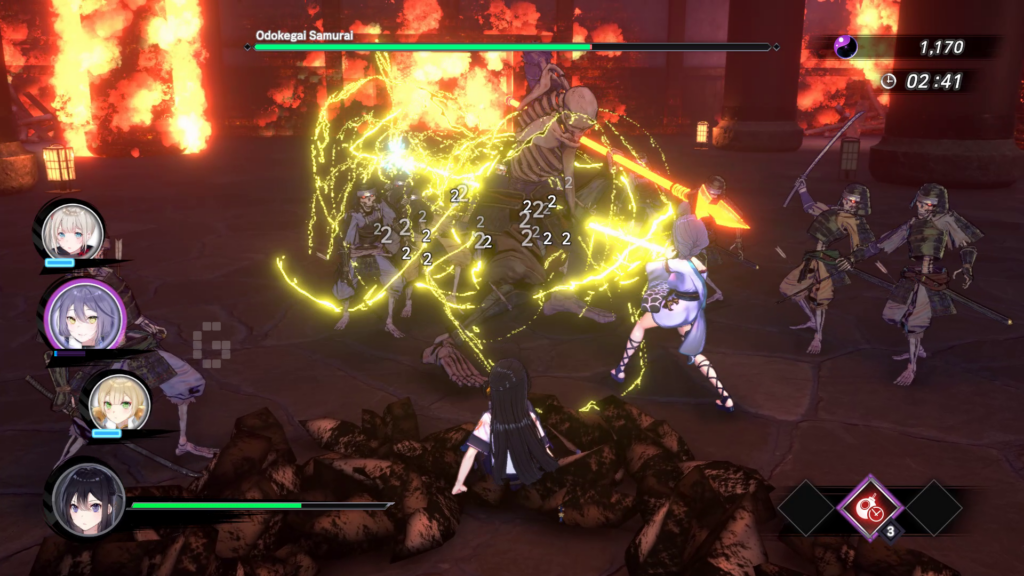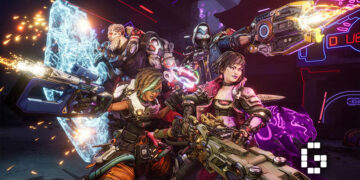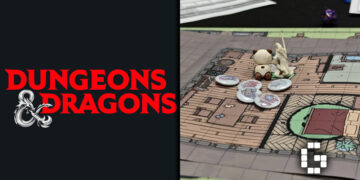As a connoisseur of action games, my quest for good looking character action led me to Samurai Maiden– an anime style hack n slash with, how should I put it, undertones. Last we left off, this quest kicked off with Gungrave GORE- a game I really wanted to like but whose dated presentation and design ended up leaving my affection decaying like a radioactive isotope witha bad dodge button.
Considering it actually looks like it came out this decade, Samurai Maiden had a pretty easy lay-up to be a slam dunk title. Cute anime girls, tag-based combat and Kiryu Kazuma VA Takaya Kuroda voicing Oda Nobunaga, what else could you want in a game?
Well, first impressions aside, a lot more, apparently. Because the story of Samurai Maiden is a good one for game designers- one that says your elevator pitch needs a good follow-up.
It’s Got The Sauce, But In One Of Those Tiny Sample Packets
As someone who’s played a lot of Musou clones, the bar wasn’t particularly high for Samurai Maiden. At the start of the game, it pretty much seemed like a game modeled after your Omega-W specialty with a pretty restrictive light combo and single-hit heavy combo. Once you get out of the tutorial though, you’re introduced to the game’s main focus: the affection system.
Tsumugi, your main character, is flanked by three niche-fulfilling party members, all with their own affection systems. Switching between each of the girls as your assists and getting kills builds their affection points, which unlocks special scenes that in turn also unlock new moves. What I really love about this is that the new moves you unlock are actually functional- one of the earliest ones you get with Iyo, for example, is a proper combo for your heavy slash, making it way more viable.

It’s even better because each of the girls covers a specific type of move, so you know which ones you want to farm affection with if you want progress in that type of kit. Hagane, your court-mandated Onee-san type has her whole skill tree built around air combos- one of her earliest moves is a straight up Aerial Rave from Devil May Cry, and at around Affection Level 40 you even unlock a jump cancel.
One of the most radical actors though is the fox girl, Komimi. Aside from being voiced by the same voice actor as Chuchu from Gundam: The Witch From Mercury, her skill tree is entirely defense-oriented, letting you do things like fast recovery, as well as the game’s parry. The best bit is that her assist skill is so good that even if you don’t much care for the bratty tsundere archetype you end up leveling her up much faster than the rest of the gang just because her assist skill is a huge AOE.
Just getting the girls to over level 50 in affection (which doesn’t take all that long, mind you) and your moveset feels incredibly robust- Tsumugi is immediately thrown up the ladder of Character Action, which is a great feeling.
These Girls Need Polish
That being said, how the game lets you access these moves is a bit of a problem. One feature Devil May Cry got right with its moves is that any move with a specific input required the use of the lock-on button to do it. Samurai Maiden goes way more haphazard with its inputs, trusting that at no point is it going to mistake running and then doing an attack for a forward>attack input (spoiler: It does. All the time).
The result is that your moves just feel sloppy. That jump cancel I mentioned earlier doesn’t feel nearly as tight as other games that have it, and it always feels like the game’s internal logic almost doesn’t know that you have these tools.
It gets at its all-time worst with the parry. The parry button is actually pretty well-designed in terms of risk vs reward. The recovery is so long that you only get one shot per attack to use it. But because it’s also bound to the dodge button (it replaces your neutral dodge) and the attacks have different timings for dodging vs parrying, you’re going to find yourself more often than not accidentally dodging, eating a big swing and then losing half your health from your opponent.
It also doesn’t help that most of those assist abilities your party have often times just don’t really work. Both Hagane and Iyo’s skills will fire at where the enemy you’re soft-locked to was at the time of casting, and the hitboxes are so small that if they so much as move two steps to the right they’ll instantly miss. Considering your own moves have a ton of knockback to them, you can see how this is a problem when the game consistently tells you you should be comboing into the assists and vice versa.

This kind of stuff is so frustrating because the game itself has so many cool ideas. The heavily featured Devoted Heart is your install feature, and actually gives different buffs for which of the girls in Tsumugi’s party you end up smooching. Hagane, for example turns your dash into a damaging attack, while Komimi’s gives you a passive heal on top of making all your attacks deal secondary explosions after the initial swing.
C For Execution
While the combat in the game has a lot to praise, the actual rooms you get to use it in do not. I’m going to level with you, Samurai Maiden has some of the most boring stages I’ve ever seen, consisting of run>encounter enemy> Open next area levels mixed with incredibly boring enemy variation. The stages themselves barely feel cohesive, since one of the levels feature staircases and side paths that literally go nowhere.
The limited enemy pool really tips its hand when the game’s solution to difficulty is to just continuously chuck more of them at you. Minibosses and Stage Bosses are pretty much interchangeable, and the only difference will be that the Stage Bosses get a fancy health bar at the top of the screen. On one hand, I like the idea of the Doom-esque “Combat Chess” approach. But Samurai Maiden’s enemies feel so boring and undiverse it’s like I’m watching Full House instead of playing what should have been a slam dunk.

Worse still is that nothing you do has any real protection from the hordes of enemies- some of the assist skills will totally fail in the face of a random skeleton with a spear, and in the case of Iyo’s item-based ability can literally send you back to square one since getting hit can cause her to drop a timed bomb at your feet. I don’t mind the “make sure you’re safe to use this” approach of attack openings but the fact of the matter is Samurai Maiden so enjoys chucking skeletons at you that you’re rarely ever truly free enough to use any of the game’s coolest tools.
The real kicker is the game’s checkpoint system. Unlike games like Devil May Cry which might just deduct your overall level score for having to restart from a checkpoint, Samurai Maiden has this absurd two-death rule: if you reach a checkpoint shrine, you can resurrect there after one death. This is a clean restart, with all your items restored as they were when you first hit the shrine. On the second death though, you’re out and have to reload the whole level.
It really caps off just how bad the stage design is since once you’re at a challenging encounter, you’re going to keep dying to it and play the entire trek back to the boss, really exposing how much of the game’s difficulty is just hurling a box of Warhammer miniatures at you.
For The Love Of God, Shut Up

Of course, it’d be remiss to not talk about the game’s incessant love of not shutting up. Samurai Maiden features fully voiced cutscenes, which are impressive for just how much everyone talks. I should stress that these are all actually really high-quality- the problem is just that they drag on forever, really killing the momentum if you’re having a binge session with the game.
The worst part is a lot of it tends to be just kind of meandering. While Tsumugi’s chemistry with the cast is genuinely quite charming, there’s something about just wanting to do sick combos then being stonewalled by a bunch of girls bickering about how gay it is to hold hands while sleeping that really irks me. The game’s use of “cuts” to act as camera cuts has just enough delay between shots that you think the cutscene’s over, and just piles on the frustration.
Like I said, there’s no way I can imagine that fixes this problem- it comes largely from the fact that the part of any brain that does combos and the part that reads about gals being pals are fundamentally different, and maybe you shouldn’t put one after the other to keep your players hooked.
Closing Thoughts

All in all, I really wanna like Samurai Maiden. There’s a lot of really fun ideas at work here, and visually it’s one of the most impressive games with an anime art style I’ve seen. It’s a great example of a game that probably had a strong pitch- but so many of its flaws leave it feeling like it could have spent a bit more time in the oven, especially with regards to the combat encounters.
It’s very clear someone on the team has a strong love of character action- that passion shines through in the kind of decisions about what goes into the combat of Samurai Maiden. Tying it into the game’s affection system also marks a good sign of a game knowing what its focus was gonna be.
But it’s the fact that every idea it has feels poorly implemented that leaves a poor taste in the mouth. Instead of being hyped for what the game’s gonna challenge me with next, instead I’m just left with a feeling of dread that the next mission is somehow going to find new ways to cram more enemies to pelt me off screen.
Samurai Maiden Score
| Pros | Cons |
| A deep combat system... | ... with clunky implementation |
| Fun characters | ...That never shut up |
| Boring level design |

Samurai Maiden reviewed on PC. Review code provided by D3 PUBLISHER.






![[TGS2025] Forza Horizon 6 Officially Announced](https://cdn.gamerbraves.com/2025/09/Forza-Horizon-6-Announced_News_FI-360x180.jpg)




![[TGS2025] FINAL FANTASY TACTICS Returns in The Ivalice Chronicles – How Square Enix is Updating a 30-Year Classic](https://cdn.gamerbraves.com/2025/09/FFT-TGS2025_Interview_FI-360x180.jpg)
![[TGS2025] Director Naoki Hamaguchi Discusses Final Fantasy VII Remake Intergrade Coming to the Nintendo Switch 2](https://cdn.gamerbraves.com/2025/09/FF7-Switch-2-TGS2025_Interview_FI-1-360x180.jpg)
![[EXCLUSIVE] Beyond Speed: Sonic Racing: CrossWorlds Developers on Creating Tracks for Multiple Worlds and Platforms](https://cdn.gamerbraves.com/2025/09/Sonic-Racing-CrossWorlds-Email_Interview_FI-360x180.jpg)
![[EXCLUSIVE] Blending Myth and Metal – Sword Sage: Awakening Dev Team Talks Inspiration and Accessibility](https://cdn.gamerbraves.com/2025/09/SwordSageInterview_Interview_FI-360x180.jpg)

![[EXCLUSIVE] Inside GameCharge: A Veteran’s Vision for Making Game Pin Purchases Convenient and Reliable](https://cdn.gamerbraves.com/2025/09/GameCharge_Interview_FI-360x180.jpg)


![[GUIDE] Etheria: Restart Tier List For September](https://cdn.gamerbraves.com/2025/09/Etheria-restart-tier-list-september_News_FI-350x250.jpg)
![[GUIDE] Etheria: Restart Codes for September and How To Redeem Them](https://cdn.gamerbraves.com/2025/09/Etheria-restart-codes_News_FI-350x250.jpg)
![[TGS2025] KILLER INN Preview – A Deadly Game of Trust and Betrayal](https://cdn.gamerbraves.com/2025/09/KILLER-INN-TGS2025_Preview_FI-350x250.jpg)






![[GIVEAWAY] SHINOBI: Art of Vengeance Delivers the Deep Combat Modern Action Gamers Want](https://cdn.gamerbraves.com/2025/08/Shinobi_Feature_FI-360x180.jpg)

